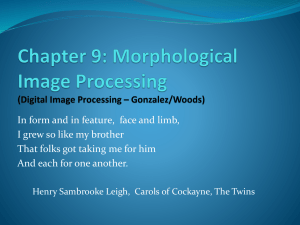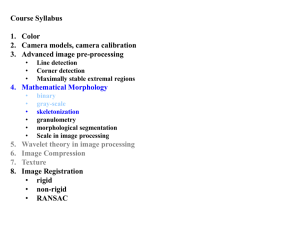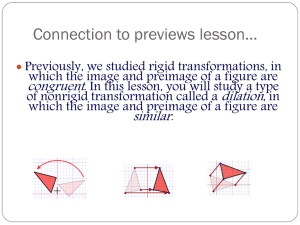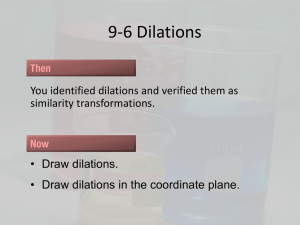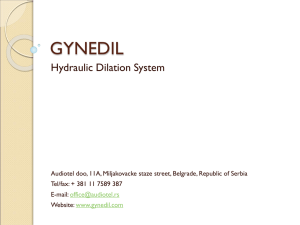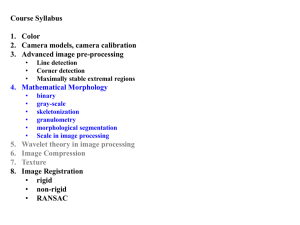ImageMorphology
advertisement
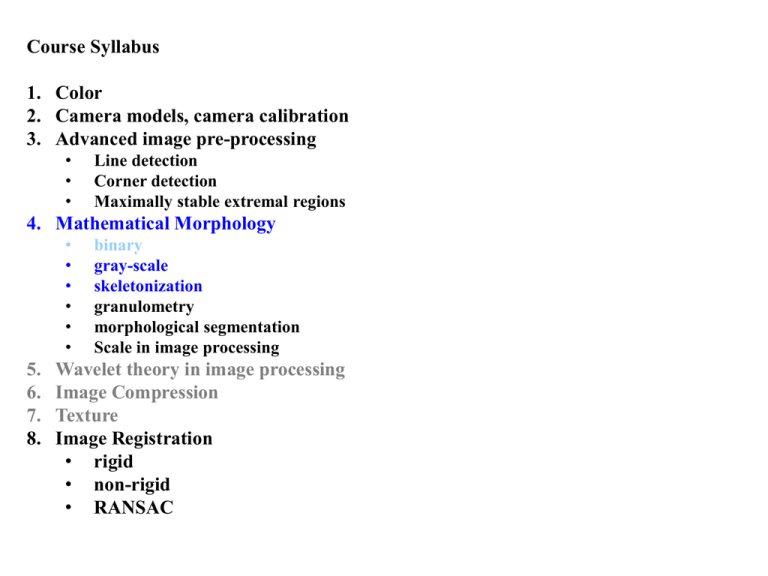
Course Syllabus 1. Color 2. Camera models, camera calibration 3. Advanced image pre-processing • • • Line detection Corner detection Maximally stable extremal regions 4. Mathematical Morphology • • • • • • 5. 6. 7. 8. binary gray-scale skeletonization granulometry morphological segmentation Scale in image processing Wavelet theory in image processing Image Compression Texture Image Registration • rigid • non-rigid • RANSAC 13.4 Gray-scale dilation and erosion • Binary morphological operations are extendible to gray-scale images using the ‘min’ and ‘max’ operations. • Erosion – assigns to each pixel minimum value in a neighborhood of corresponding pixel in input image o structuring element is richer than in binary case o structuring element is a function of two variables, specifies desired local gray-level property o value of structuring element is subtracted when minimum is calculated in the neighborhood • Dilation – assigns maximum value in neighborhood of corresponding pixel in input image o value of structuring element is added when maximum is calculated in the neighborhood 13.4 Gray-scale dilation and erosion continued • Such extension permits topographic view of gray-scale images o gray-level is interpreted as height of a particular location of a hypothetical landscape o light and dark spots in the image correspond to hills and valleys o such morphological approach permits the location of global properties of the image valleys mountain ridges (crests) watersheds 13.4 Gray-scale dilation and erosion continued Concepts of umbra and top of the point set Set A 13.4 Gray-scale dilation and erosion continued Concepts of umbra and top of the point set Gray-scale dilation is expressed as the dilation of umbras. 13.4.1 Top surface, umbra, and gray-scale dilation and erosion • point set 𝐴 ⊂ ℰ 𝑛 • first 𝑛 − 1 co-ordinates ... spatial domain • 𝑛th co-ordinate ... function value (brightness) • The top surface of set 𝐴 = function defined on the 𝑛 − 1 dimensional support • for each 𝑛 − 1 -tuple, top surface is the highest value of the last co-ordinate of 𝐴 for each 𝑛 − 1 -tuple • if 𝐴 is Euclidean, highest value means supremum Figure 13.12: Top surface of the set A corresponds to maximal values of the function 𝑓 𝑥1 , 𝑥2 . 13.4.1 Top surface, umbra, and gray-scale dilation and erosion • point set 𝐴 ⊂ ℰ 𝑛 • support 𝐹 = 𝑥 ∈ ℰ 𝑛−1 for some 𝑦 ∈ ℰ, 𝑥, 𝑦 ∈ 𝐴 • top surface 𝑇 𝐴 is mapping 𝐹 ⟶ ℰ 𝑇 𝐴 𝑥 = max 𝑦, 𝑥, 𝑦 ∈ 𝐴 Figure 13.12: Top surface of the set A corresponds to maximal values of the function 𝑓 𝑥1 , 𝑥2 . • umbra of function f is defined on some subset F (support) of (n−1)dimensional space • umbra – region of complete shadow when obstructing light by nontransparent object • umbra of f ... set consisting of top surface of f and everything below it Figure 13.13: Umbra of the top surface of a set is the whole subspace below it. • let 𝐹 ⊆ ℰ 𝑛−1 and 𝑓 ∶ 𝐹 → ℰ 𝑛−1 • umbra 𝑈 𝑓 ⊆ 𝐹 × ℰ 𝑈 𝑓 = 𝑥, 𝑦 | 𝑥 ∈ 𝐹, 𝑦 ≤ 𝑓 𝑥 • umbra of an umbra of f is an umbra. Figure 13.14: Example of a 1D function (left) and its umbra (right). • umbra of an umbra of f is an umbra. Gray-scale Dilation • gray-scale dilation of two functions ... top surface of the dilation of their umbras • let 𝐹, 𝐾 ⊆ ℰ 𝑛−1 and 𝑓 ∶ 𝐹 → ℰ and 𝑘 ∶ 𝐾 → ℰ • dilation ⊕ of f by k, f ⊕ k : F ⊕ K → ℰ is defined by 𝑓⊕𝑘 =𝑇 𝑈 𝑓 ⊕𝑈 𝑘 ⊕ on the left-hand side is dilation in the gray-scale image domain ⊕ on the right-hand side is dilation in the binary image • no new symbol introduced • the same applies to erosion ⊖ later • similar to binary dilation o first function f represents image o second function k represents structuring element Gray-scale Dilation: Illustration Figure 13.14: Example of a 1D function (left) and its umbra (right). Figure 13.15: A structuring element: 1D function (left) and its umbra (right). Figure 13.16: 1D example of gray-scale dilation. The umbras of the 1D function f and structuring element k are dilated first, U[f] ⊕ U[k]. The top surface of this dilated set gives the result, f ⊕ k = T(U[f] ⊕ U[k]) . • This explains what gray-scale dilation means • does not give a reasonable algorithm for actual computations in hardware • computationally plausible way to calculate dilation ... taking the maximum of a set of sums: 𝑓 ⊕ 𝑘 𝑥 = max 𝑓 𝑥 − 𝑧 + 𝑘 𝑧 , 𝑥 − 𝑧 ∈ 𝐹, 𝑧 ∈ 𝐾 • computational complexity is the same as for convolution in linear filtering, where a summation of products is performed • Case: when the structuring element is binary 𝑓 ⊕ 𝐾 𝑥 = max 𝑓 𝑥 − 𝑧 , 𝑥 − 𝑧 ∈ 𝐹, 𝑧 ∈ 𝐾 Gray-scale Erosion • • • • • definition of gray-scale erosion is analogous to gray-scale dilation. gray-scale erosion of two functions (point sets) Takes their umbras. Erodes them using binary erosion. Gives the result as the top surface. • let 𝐹, 𝐾 ⊆ ℰ 𝑛−1 and 𝑓 ∶ 𝐹 → ℰ and 𝑘 ∶ 𝐾 → ℰ • erosion ⊖ of f by k, f ⊖ k : F ⊖ K → ℰ is defined by 𝑓⊖𝑘 =𝑇 𝑈 𝑓 ⊖𝑈 𝑘 • to decrease computational complexity, the actual computations performed as the minimum of a set of differences (notice similarity to correlation) 𝑓 ⊖ 𝑘 𝑥 = min 𝑓 𝑥 − 𝑧 − 𝑘 𝑧 , 𝑥 − 𝑧 ∈ 𝐹, 𝑧 ∈ 𝐾 • Case: when the structuring element is binary 𝑓 ⊖ 𝐾 𝑥 = min 𝑓 𝑥 − 𝑧 , 𝑥 − 𝑧 ∈ 𝐹, 𝑧 ∈ 𝐾 Gray-scale Erosion: Illustration Figure 13.14: Example of a 1D function (left) and its umbra (right). Figure 13.15: A structuring element: 1D function (left) and its umbra (right). Figure 13.17: 1D example of gray-scale erosion. The umbras of 1D function f and structuring element k are eroded first, U[f] ⊖ U[k]. The top surface of this eroded set gives the result, f ⊖ k = T( U[f] ⊖ U[k] ) Example • • • • • microscopic image of cells corrupted by noise aim is to reduce noise and locate individual cells 3×3 structuring element used for erosion/dilation individual cells can be located by the reconstruction operation (Section 13.5.4) original image is used as a mask and the dilated image in Figure 13.18c is an input for reconstruction • black spots in (d) panel depict cells Figure 13.18: Morphological pre-processing: (a) cells in a microscopic image corrupted by noise; (b) eroded image; (c) dilation of (b), the noise has disappeared; (d) reconstructed cells. Courtesy of P. Kodl, Rockwell Automation Research Center, Prague, Czech Republic. 13.4.2 Opening and Closing Gray-scale opening and closing • defined as in binary morphology • Gray-scale opening f ◦ k = (f ⊖ k) ⊕ k • gray-scale closing f • k = (f ⊕ k) ⊖ k • duality between opening and closing is expressed as (𝑘 means transpose) − 𝑓∘𝑘 𝑥 = −𝑓 • 𝑘 (𝑥) • opening of f by structuring element k can be interpreted as sliding k on the landscape f • position of all highest points reached by some part of k during the slide gives the opening, • similar interpretation exists for erosion • Gray-scale opening and closing often used to extract parts of a gray-scale image with given shape and gray-scale structure 13.4.3 Top hat transformation • simple tool for segmenting objects in gray-scale images that differ in brightness from background even when background is uneven • top-hat transform superseded by watershed segmentation for more complicated backgrounds • gray-level image X, structuring element K • residue of opening as compared to original image 𝑋 ∕ 𝑋 ∘ 𝐾 is top hat transformation • good tool for extracting light (or dark) objects on dark (light) possibly slowly changing background • parts of image that cannot fit into structuring element K are removed by opening • Subtracting opened image from original – removed objects stand out clearly • actual segmentation performed by simple thresholding Figure 13.19: The top hat transform permits the extraction of light objects from an uneven background. Example from visual industrial inspection • glass capillaries for mercury maximal thermometers had the following problem: thin glass tube should be narrowed in one particular place to prevent mercury falling back when the temperature decreases from the maximal value done by using a narrow gas flame and low pressure in the capillary • capillary is illuminated by a collimated light beam—when the capillary wall collapses due to heat and low pressure, an instant specular reflection is observed and serves as a trigger to cover the gas flame • Originally, machine was controlled by a human operator who looked at the tube image projected optically on the screen; the gas flame was covered when the specular reflection was observed • task had to be automated and the trigger signal obtained from a digitized image ⇒ specular reflection is detected by a morphological procedure Figure 13.20: An industrial example of gray-scale opening and top hat segmentation, i.e., image-based control of glass tube narrowing by gas flame. (a) Original image of the glass tube, 512×256 pixels. (b) Erosion by a one-pixel-wide vertical structuring element 20 pixels long. (c) Opening with the same element. (d) Final specular reflection segmentation by the top hat transformation. Courtesy of V. Smutný, R. Šára, CTU Prague, P. Kodl, Rockwell Automation Research Center, Prague, Czech Republic. 13.5 Skeletons and object marking 13.5.1 Homotopic transformations • transformation is homotopic if it does not change the continuity relation between regions and holes in the image. • this relation expressed by homotopic tree o its root ... image background o first-level branches ... objects (regions) o second-level branches ... holes o etc. • transformation is homotopic if it does not change homotopic tree Homotopic Tree Homotopic Tree Homotopic Tree Homotopic Tree r1 r2 h2 h1 b r1 r2 h2 h1 Quitz: Homotopic Transformation • What is the relation between an element in the ith and i+1th levels? 13.5.2 Skeleton, maximal ball • skeletonization = medial axis transform • ‘grassfire’ scenario • A grassfire starts on the entire region boundary at the same instant – propagates towards the region interior with constant speed • skeleton S(X) ... set of points where two or more fire-fronts meet Figure 13.22: Skeleton as points where two or more fire-fronts of grassfire meet. • Formal definition of skeleton based on maximal ball concept • ball B(p, r), r ≥ 0 ... set of points with distances d from center ≤ r • ball B included in a set X is maximal if and only if there is no larger ball included in X that contains B Figure 13.23: Ball and two maximal balls in a Euclidean plane. Figure 13.24: Unit-size disk for different distances, from left side: Euclidean distance, 6-, 4-, and 8connectivity, respectively. • plane ℝ2 with usual Euclidean distance gives unit ball 𝐵𝐸 • • • • three distances and balls are often defined in the discrete plane ℤ2 if support is a square grid, two unit balls are possible: 𝐵4 for 4-connectivity 𝐵8 for 8-connectivity • skeleton by maximal balls 𝑆 𝑋 of a set 𝑋 ⊂ ℤ2 is the set of centers p of maximal balls 𝑆 𝑋 = 𝑝 ∈ 𝑋 ∶ ∃𝑟 ≥ 0, 𝐵 𝑝, 𝑟 is a maximal ball of 𝑋 • • • • this definition of skeleton has intuitive meaning in Euclidean plane skeleton of a disk reduces to its center skeleton of a stripe with rounded endings is a unit thickness line at its center etc. Figure 13.25: Skeletons of rectangle, two touching balls, and a ring. • • • • skeleton by maximal balls – two unfortunate properties does not necessarily preserve homotopy (connectivity) some of skeleton lines may be wider than one pixel skeleton is often substituted by sequential homotopic thinning that does not have these two properties • dilation can be used in any of the discrete connectivities to create balls of varying radii • nB = ball of radius n 𝑛𝐵 = 𝐵⨁𝐵⨁ … ⨁ 𝐵 • skeleton by maximal balls ... union of the residues of opening of set X at all scales ∞ 𝑆 𝑋 = 𝑋 ⊖ 𝑛𝐵 ∖ 𝑛=0 𝑋 ⊖ 𝑛𝐵 ∘ 𝐵 • trouble : skeletons are disconnected - a property is not useful in many applications • homotopic skeletons that preserve connectivity are preferred
